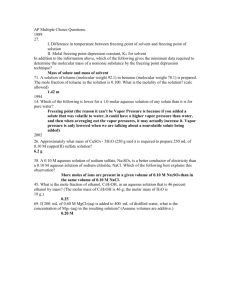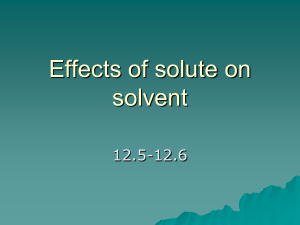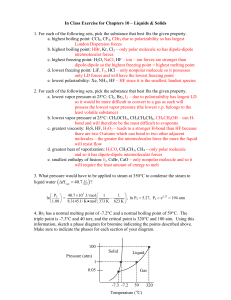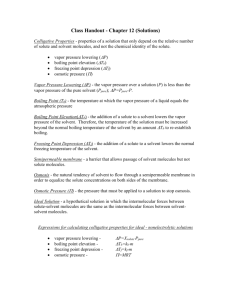pptx
advertisement
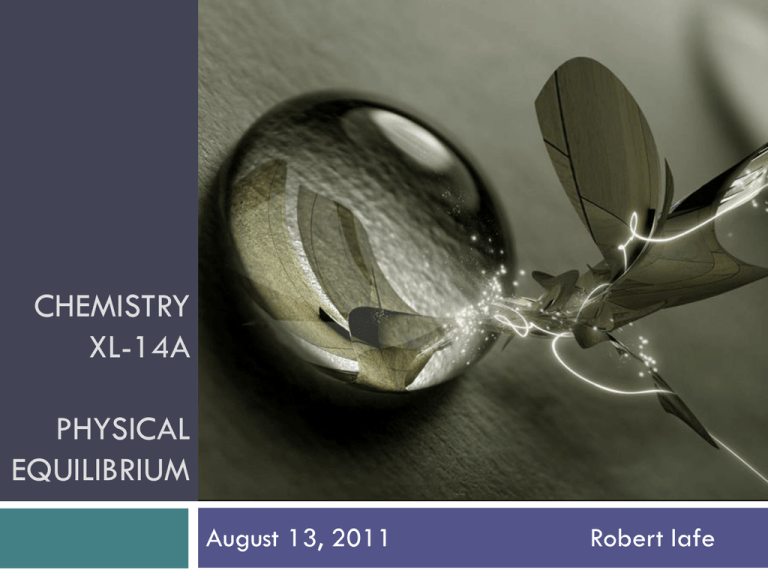
CHEMISTRY
XL-14A
PHYSICAL
EQUILIBRIUM
August 13, 2011
Robert Iafe
Final Information
2
3 hours - Equivalent to 2 midterms
Cheat sheet – one (1) page, single sided
Graphing calculators ok
Chapter Overview
3
Phases and Phase Transitions
Solubility
Colligative Properties
Binary Liquid Mixtures
Phases and Phase Transitions
4
Vapor Pressure
Volatility
Intermolecular Forces (Chapter 4)
Ion-Dipole Forces
Dipole-Dipole Forces
Londen Forces
Hydrogen Bonding
Variation of Vapor Pressure with Temperature
Boiling
Freezing and Melting
Phase Diagrams
Critical Properties
Origin of Intermolecular Forces
5
Intermolecular forces are
responsible for phases of matter
Phase: form of matter that is
uniform in both chemical
composition and physical state
Gas
Liquid
Solid
All intermolecular interactions can
be traced back to the coulombic
interaction between charges
Origin of Intermolecular Forces
6
Coulombic interaction
Q1Q2
Ep
4o r
Deep well indicates a bond
between atoms
Shallow well shows small
attractive forces between
molecules, even though no
bonds are formed
Ion-Dipole Forces
7
Ionic solids dissolve in water when water molecules become
attached to each ion and separate it from the other ions
Hydration due to dipole of water
Partial positive interacts with anion
Partial negative interacts with cation
Ion-Dipole interaction
Potential Energy
8
Potential energy for the interaction of a full charge and
partial charges
Potential energy is lowered by interaction with polar
solvent
Distance of the ion and dipole play a larger role than
distance between the two ions
Results:
Small cations are more extensively hydrated than large cations
Smaller metals form hydrated salts
Larger charges on metals cause hydration
z
Ep 2
r
Dipole-Dipole Forces
9
Polar molecules attract each other by the interaction
between the partial charges of their electric dipoles
Dipole-Dipole interaction
Ep
12
r
3
London Forces
10
Attractive interactions are also found in nonpolar molecules
Evidence: noble gases can be liquefied even though they are
nonpolar
Electrons are not stationary
Nonpolar molecules can have instantaneous dipoles
Attractive interactions are called London interactions
London Forces
11
What determines strength of London interactions?
Distance
Polarizability
(alpha)
Shape
E p
1 2
r
6
London Forces - Polarizability
12
More electrons = More polarizable
More polarizable = more stabilization
London Forces - Shape
13
Bp: 36 oC
Bp: 10 oC
Trends in London Forces
14
Hydrogen Bonding
15
Ammonia (NH3), water (H2O), and HF have
abnormally high boiling points
Strong attractive forces due to hydrogen bonding
Hydrogen bonding only occurs with N-H, O-H, F-H
Vapor Pressure
16
The vapor pressure of a
substance is the pressure
exerted by its vapor when the
vapor is in dynamic equilibrium
with the condensed phase
Vapor Pressure and IM
17
Intermolecular forces play a large role in physical
properties of liquids and solids
General rule:
Molecules with stronger intermolecular forces have lower
vapor pressures (higher boiling points and melting points)
Molecules with weaker intermolecular forces have higher
vapor pressures (lower boiling points and melting points)
Vapor Pressure and IM
18
Vapor Pressure and Temperature
19
Vapor pressure increases
with temperature
Higher
temperature =
greater energy to overcome
attractive forces of the liquid
Clausius-Clapeyron equation
P2 H vap 1 1
ln
P1
R T1 T2
Boiling
20
Boiling occurs when the vapor pressure of a liquid is
equal to the external (atmospheric) pressure
Normal
boiling point = boiling point at 1 atm (760 torr)
Boiling point is dependent on:
Intermolecular
forces
External Pressure
Thinking
Does
P2 H vap 1 1
ln
P1
R T1 T2
questions
water boil at a higher or lower temperature on the top of
Mt. Everest?
How does a pressure cooker work?
Freezing and Melting
21
Freezing temperature is the temperature at which the
solid and liquid phase are in dynamic equilibrium with
each other
Normal
freezing point = freezing point at 1 atm (760 Torr)
Supercooling = when a liquid exists beyond its freezing
point
Phase Diagrams
22
Phase diagram of water
Phase boundaries
Equilibrium
Triple point
All
btwn phases
3 phases coexist
Solid-liquid boundary
Negative
slope = solid is
less dense than liquid
(ice floats in water)
Water
23
CO2
24
Sulfur
25
Critical Points
26
Supercritical
fluid
Solubility
27
The Limits to Solubility
The “Like-Dissolves-Like” Rule
Pressure and Gas Solubility: Henry’s Law
Temperature and Solubility
Limits of Solubility
28
Terms:
Solvent:
the substance that dissolves
Solute: the substance that is dissolved
Saturated: the solvent has dissolved the maximum
amount of solute it can, and undissolved solute remains
Saturation is a dynamic equilibrium with the
undissolved solute
Like Dissolves Like
29
Substances have attractive cohesion forces when the
have the same intermolecular forces
Rule: Like Dissolves Like
Polar
solvents dissolve polar solutes
Nonpolar solvents dissolve nonpolar solutes
Polar liquids and nonpolar liquids are immiscible
Detergents
30
Detergents have a hydrophobic tail group and a
hydrophilic head group
Hydrophobic
‘hydro’
= water; ‘phobic’ = afraid
Hydrophilic
‘hydro’
– does not dissolve in water
– dissolved in water
= water; ‘philic’ = loves
micelle
Pressure and Gas Solubility: Henry’s Law
31
English chemist William Henry, 1801
The solubility of a gas is directly proportional to its
partial pressure, P
Henry’s Law
s kH P
Temperature and Solubility
32
Rate of dissolving, but not generally the solubility of a
substance, increases at higher temperatures.
Most gasses are less soluble in warm water than in cold
water
Colligative Properties
33
Molality
Vapor-Pressure Lowering
Boiling-Point Elevation
Freezing Point Depression
Osmosis
Molality
34
Three measures of concentration
Mole
fraction
Molarity
Molality
x solute
nsolute
nsolute nsolvent
nsolute mol
M
Lsolution
L
nsolute
mol
bsolute
msolvent (kg)solvent
Molality
and
mole
fraction
are
independent
of
temperature
Mole Fraction Molality
35
What is the molality of benzene, C6H6, dissolved in toluene, C6H5CH3, in
a solution for which the mole fraction of benzene is 0.150?
Step
1. Find the amount of solute molecules in a total of
exactly 1 mol of solution molecules
n solute xsolute ntotal 0.150 1mol 0.150mol
Step
2. Find the mass of solvent present and convert to kg
msolvent {(1 x solute)mol} MM solvent
g
1kg
msolvent {(1 0.150)mol} 92.13
0.0783kg
mol 1000g
Step
3. Calculate the molality
nsolute 0.150mol
mol
bsolute
1.92
msolvent 0.0783kg
kg
Molarity Molality
36
Find the molality of sucrose, C12H22O11, in 1.06 M C12H22O11(aq),
which is known to have density 1.14g/mL
1. Find the mass of exactly 1 L (103 mL) of solution
msolution d (10 3 mL) 1.14 10 3 g
Step 2. Find the mass of solute in exactly 1 L of solution
Step
msucrose n soluteMM solute c solute (1L) MM solute
mol
g
msucrose 1.06
(1L) 342.3
363g
L
mol
Step 3. Find the mass of water present in exactly 1 L of sol’n
mwater msolution msolute 1140 363g 0.78kg
1.06mol
mol
Step 4. Calculate molality.
b(C1 2 H 2 2O1 1 )
1.4
0.78kg
kg
Vapor Pressure Lowering
37
French scientist Francois-Marie Raoult
Spent most of his time measuring vapor
pressure
Vapor pressure of a solvent is
proportional to its mole fraction in a
solution
Ideal solutions follow Raoult’s law
The vapor pressure of a solvent is
reduced by the presence of a
nonvolatile solute
P x solventPpure
Boiling Point Elevation
38
Presence of nonvolative solutes raises the boiling
point of pure liquids
Tb ikb bsolute
i = van’t Hoff i factor
(# of particles)
eg. NaCl = 2
CaCl2 = 3
Sucrose = 1
Freezing Point Depression
39
Presence of nonvolative solutes lowers the freezing
point of pure liquids
Tf ik f bsolute
i = van’t Hoff i factor
(# of particles)
eg. NaCl = 2
CaCl2 = 3
Sucrose = 1
Practice Problems
40
What is the change in boiling point when you add 26 g
of sucrose (C6H12O6) to 1.00 kg of water?
What is change in freezing point when you add 10 g
of NaCl to 1.00 kg of water?
Osmosis
41
Definition: the flow of solvent through a membrane
into a more concentrated solution
The pressure needed to
stop the flow of solvent is
called the osmotic
pressure, Π
iRTc solute
Binary Liquid Mixtures
42
Vapor Pressure of Binary Liquid Mixtures
Distillation
Azeotropes
Vapor pressure of Binary Liquid
Mixtures
43
The vapor pressure of a
mixture of two volatile liquids
is the sum of their individual
partial pressures
PA x A (l)P
*
A
PB x B (l)P
P PA PB
*
B
Distillation
44
The vapor pressure of a binary
mixture is intermediate between
the 2 volatile liquids
Temperature-composition diagram
Upper curve = vapor composition
Horizontal line = tie line
Distillate = condensed vapor
Fractional Distillation
45
Continuous redistillation leads to
purer and purer distillate
Becomes richers in the substance
with the lower boiling point
Azeotropes
46
Most liquid mixtures are not ideal, so their vapor pressures do not
follow Raoult’s law
Positive deviation
Negative deviation
Impact on Biology and Materials
47
Colloids
Colloids
48
Colloid: a dispersion of large particles (1 nm to 1 μm in
diameter) in a solvent
Colloids have properties between those of a
homogeneous solution and a heterogeneous mixture
Tyndall Effect
49
Because colloids are a dispersion of many tiny
particles in a solvent, we can see the Tyndall Effect
The
beam reflects off each individual particle
Laser beam through silver solution



